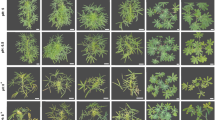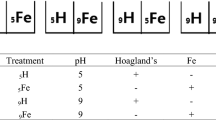Abstract
Background and aims
Although phosphite (PO3, Phi) cannot replace phosphate (PO4, Pi) as a nutritional source of phosphorus (P) for plants, decisions about using foliar Phi application in citrus groves scarcely take into account P availability and plant nutritional status. Accordingly, we studied the interactive effects of P supply in the rooting medium and foliar sprays of Pi or Phi on citrus tree performance and leaf anatomy and ultrastructure.
Methods
Young sweet orange trees were grown hydroponically using P-deficient (PD) or P-sufficient (PS) nutrient solutions for 15 weeks in combination with 3 foliar spray treatments: 0.16 M P in the form of Pi (KH2PO4) or Phi (KH2PO3) and a control spray of 0.16 M potassium chloride (KCl). Six foliar sprays were applied to the drip point at 15-day intervals during the experimental period. Before the trees were harvested to estimate growth, mature leaves were sampled to study the anatomical and ultrastructural organization and to evaluate P concentration.
Results
Under PD, the Pi spray stimulated tree growth compared with the control, whereas Phi sprays impaired tree performance, suggesting toxic effects. Both Pi and Phi applications increased the leaf P concentration relative to that of the control. Leaves of PD trees exposed to Phi exhibited pronounced damage to the epidermis, and stomata showed deformed ostioles and surface flaking. Moreover, phloem and xylem vessels were disorganized, cell wall presented sinuosity, cell membranes were plasmolyzed, and chloroplast thylakoids were disrupted, with accumulation of starch and plastoglobuli. However, no similar changes were observed either in PD trees under Pi spray or in PS trees independent of foliar treatment. PD trees receiving KCl exhibited intermediate responses between those of Pi and Phi applications.
Conclusions
This was the first study to demonstrate that Phi spray disrupts the anatomical and ultrastructural organization of citrus leaves under P deficiency. Our results provide insights into the mechanisms explaining the poor nutritional value of Phi and support information to guide the use of Phi-based products.








Similar content being viewed by others
References
Albrigo LG (1999) Effects of foliar applications of urea or Nutriphite on flowering and yields of Valencia orange trees. Proc Fla State Hort Soc 112:1–4
Bataglia OC, Furlani AMC, Teixeira JPF, Furlani PR, Gallo JR (1983) Método de análise química de plantas. Instituto Agronômico, Campinas, Brazil
Berkowitz O, Jost R, Kollehn DO, Fenske R, Finnegan PM, O’Brien PA, Hardy GE, Lambers H (2013) Acclimation responses of Arabidopsis thaliana to sustained phosphite treatments. J Exp Bot 64:1731–1743
Bondada BR, Syvertsen JP (2005) Concurrent changes in net CO2 assimilation and chloroplast ultrastructure in nitrogen deficient citrus leaves. Environ Exp Bot 54:41–48
Calvo P, Nelson L, Kloepper JW (2014) Agricultural uses of plant biostimulants. Plant Soil 383:3–41
Carswell C, Grant BR, Theodorou ME, Harris J, Niere JO, Plaxton WC (1996) The fungicide phosphonate disrupts the phosphate starvation response in Brassica nigra seedlings. Plant Physiol 110:105–110
Carswell C, Grant BR, Theodorou ME, Plaxton WC (1997) Disruption of the phosphate-starvation response of oilseed rape suspension cells by the fungicide phosphonate. Planta 203:67–74
Danova-Alt R, Dijkema C, De Waard P, Köck M (2008) Transport and compartmentation of phosphite in higher plant cells - kinetic and 31P nuclear magnetic resonance studies. Plant Cell Environ 31:1510–1521
Eichert T, Peguero-Pina JJ, Gil-Pelegrín E, Heredia A, Fernández V (2010) Effects of iron chlorosis and iron resupply on leaf xylem architecture, water relations, gas exchange and stomatal performance of field-grown peach (Prunus persica). Physiol Plant 138:48–59
Eshraghi L, Anderson JP, Aryamanesh N, McComb JA, Shearer B, Hardy GESJ (2014) Defence signalling pathways involved in plant resistance and phosphite-mediated control of Phytophthora Cinnamomi. Plant Mol Biol Rep 32:342–356
Feder N, O'Brien TP (1968) Plant microtechnique: some principles and new methods. Am J Bot 55:123–142
Fernández V, Brown PH (2013) From plant surface to plant metabolism: the uncertain fate of foliar applied nutrients. Front Plant Sci 4:289
Fernández V, Eichert T, Del Río V, López-Casado G, Heredia-Guerrero JA, Abadía A, Heredia A, Abadía J (2008) Leaf structural changes associated with iron deficiency chlorosis in field-grown pear and peach: physiological implications. Plant Soil 311:161–172
Fernández V, Guzmán P, Peirce CAE, McBeath TM, Khayet M, McLaughlin MJ (2014) Effect of wheat phosphorus status on leaf surface properties and permeability to foliar applied phosphorus. Plant Soil 384:1–14
Forschner W, Schmitt V, Wild A (1989) Investigations on the starch content and ultrastructure of spruce needles relative to the occurrence of novel forest decline. Bot Acta 102:208–221
Gao F, Calatayud V, García-Breijo G, Reig-Armiñana J, Feng Z (2016) Effects of elevated ozone on physiological, anatomical and ultrastructural characteristics of four common urban tree species in China. Ecol Indic 67:367–379
Gómez-Merino FC, Trejo-Téllez LI (2015) Biostimulant activity of phosphite in horticulture. Sci Hort 196:82–90
Heber U, Heldt HW (1981) The chloroplast envelope. Annu Rev Plant Phys 33:73–96
Hernández I, Munné-Bosch S (2015) Linking phosphorus availability with photo-oxidative stress in plants. J Exp Bot 66:2889–2900
Hossain MN, Ryu KS (2009) Effect of foliar applied phosphatic fertilizer on absorption pathways, yield and quality of sweet persimmon. Sci Hort 122:626–635
Jackson TJ, Burgess T, Colquhoun I, Hardy GESJ (2000) Action of the fungicide phosphite on Eucalyptus marginata inoculated with Phytophthora cinnamomi. Plant Pathol 49:147–154
Jost R, Pharmawati M, Lapis-Gaza HR, Rossig C, Berkowitz O, Lambers H, Finnegan PM (2015) Differentiating phosphate-dependent and phosphate independent systemic phosphate-starvation response networks in Arabidopsis thaliana through the application of phosphite. J Exp Bot 66:2501–2514
Karnovsky MJ (1965) A formaldehyde-glutaraldehyde fixative of high osmolality for use in electron microscopy. J Cell Biol 27:137–138
Lim PO, Kim HJ, Nam HG (2007) Leaf senescence. Annu Rev Plant Biol 58:115–136
Marschner H (1995) Mineral nutrition of higher plants, 2nd edn. Academic Press, San Diego
Matile P, Hortensteiner S, Thomas H, Krautler B (1996) Chlorophyll breakdown in senescent leaves. Plant Physiol 112:1403–1409
Mattos D Jr, Quaggio JA, Cantarella H, Alva AK, Graetz DA (2006) Response of young citrus trees on selected rootstocks to nitrogen, phosphorus, and potassium fertilization. J Plant Nutr 29:1371–1385
McDonald AE, Grant GR, Plaxton WC (2001) Phosphite (phosphorous acid): its relevance in the environment and agriculture and influence on plant phosphate starvation response. J Plant Nutr 24:1505–1519
Mesquita GL, Tanaka FAO, Cantarella H, Mattos D Jr (2011) Atmospheric absorption of fluoride by cultivated species. Leaf structural changes and plant growth. Water Air Soil Pollut 219:143–156
Mesquita GL, Mattos D Jr, Tanaka FAO, Cantarella H, Zambrosi FCB, Machado EC (2016a) Traits driving tolerance to atmospheric fluoride pollution in tree crops. Water Air Soil Pollut 227:420
Mesquita GL, Zambrosi FCB, Tanaka FAO, Boaretto RM, Quaggio JA, Ribeiro RV, Mattos D Jr (2016b) Anatomical and physiological responses of citrus trees to varying boron availability are dependent on rootstock. Front Plant Sci 7:224
Moor U, Poldma P, Tonutare T, Karp K, Starast M, Vool E (2009) Effect of phosphite fertilization on growth, yield and fruit composition of strawberries. Sci Hort 119:264–269
Neighbour E, Cottam DA, Mansfield TA (1988) Effects of sulphur dioxide and nitrogen dioxide on the control of water loss by birch (Betula spp.) New Phytol 108:149–157
Noack SR, McBeath TM, McLaughlin MJ (2010) Potential for foliar phosphorus fertilization of dryland cereal crops: a review. Crop Pasture Sci 61:659–669
Orbovic V, Syvertsen JP, Bright D, Van Clief DL, Graham JH (2008) Citrus seedling growth and susceptibility to root rot as affected by phosphite and phosphate. J Plant Nutr 31:774–787
Palomäki V, Holopainen T (1994) Effects of phosphorus deficiency and recovery fertilization on growth, mineral concentration, and ultrastructure of scots pine needles. Can J For Res 24:2459–2468
Papadakis IE, Bosabalidis AM, Sotiropoulos TE, Therios IN (2007) Leaf anatomy and chloroplast ultrastructure of Mn-deficient orange plants. Acta Physiol Plant 29:297–301
Pieters AJ, Paul MJ, Lawlor DW (2001) Low sink demand limits photosynthesis under pi deficiency. J Exp Bot 52:1083–1091
Qiu J, Israel DW (1992) Diurnal starch accumulation and utilization in phosphorus-deficient soybean plants. Plant Physiol 98:316–323
Ratjen AM, Gerendás J (2009) A critical assessment of the suitability of phosphite as a source of phosphorus. J Plant Nutr Soil Sci 172:821–828
Reddy SE, Majmudar AM (1983) Response of mango (Mangifera indica L) to foliar application of phosphorus. Fert Res 4:281–285
Reynolds ES (1963) The use of lead citrate at high pH an electron opaque stain in electron. J Cell Biol 17:208–212
Schaffer AA, Kang-Chien LM, Goldschmidt EE, Boyer CD, Goren R (1986) Citrus leaf chlorosis induced by sink removal: starch, nitrogen, and chloroplast ultrastructure. J Plant Physiol 124:111–121
Scott P, Bader MK-F, Williams NM (2016) Foliar phosphite application has minor phytotoxic impacts across a diverse range of conifers and woody angiosperms. Physiol Plantarum 158:124–134
Singh VK, Wood SM, Knowwles VL, Plaxton WC (2003) Phosphite accelerates programmed cell death in phosphate starved oilseed rape (Brassica napus) suspension cell culture. Planta 218:233–239
Stettler M, Eicke S, Mettler T, Messerli G, Hortensteiner S, Zeeman SC (2009) Blocking the metabolism of starch breakdown products in Arabidopsis leaves triggers chloroplast degradation. Mol Plant 2:1233–1246
Sutinen S, Wallin G, Karlsson PE, Skarby L, Selldon G (1998) Cell ultrastrucuture of needles from samplings of Norway spruce, Piceia Abies (L) karst., exposed to ozone and low phosphorus supply in open-top chambers. Chemosphere 36:691–696
Thao HTB, Yamakawa T (2009) Phosphite (phosphorous acid): fungicide, fertilizer or bio-stimulator? Soil Sci Plant Nutr 55:228–234
Thao HTB, Yamakawa T, Shibata K, Sarr PS, Myint AK (2008) Growth response of komatsuna (Brassica rapa Var. Peruviridis) to root and foliar applications of phosphite. Plant Soil 308:1–10
Thompson MV (2006) Phloem: the long and the short of it. Trends Plant Sci 11:26–32
Ticconi CA, Delatorre CA, Abel S (2001) Attenuation of phosphate starvation responses by phosphite in Arabidopsis. Plant Physiol 127:963–972
Usuda H, Shimogawara K (1991) Phosphate deficiency in maize. I. Leaf phosphate status, growth, photosynthesis and carbon partitioning. Plant Cell Physiol 32:497–504
Varadarajan DK, Karthikeyan AS, Matilda PD, Raghothama KG (2002) Phosphite, an analog of phosphate, suppresses the coordinated expression of genes under phosphate starvation. Plant Physiol 129:1232–1240
Whatley JM (1971) Ultrastructural changes in chloroplast of Phaseolus vulgaris during development under conditions of nutrient deficiency. New Phytol 70:725–742
Zambrosi FCB (2016) Phosphite and phosphate have contrasting effects on nutrient status of plants. J Crop Improv 30:421–432
Zambrosi FCB, Mesquita GL (2016) Foliar phosphorus application enhances nutrient balance and growth of phosphorus deficient sugarcane. J Agr Rural Devel Trop Subtrop 117:203–210
Zambrosi FCB, Mattos D Jr, Syvertsen JP (2011) Plant growth, leaf photosynthesis, and nutrient-use efficiency of citrus rootstocks decrease with phosphite supply. J Plant Nutr Soil Sci 174:487–495
Zambrosi FCB, Mattos D Jr, Boaretto RM, Quaggio JA, Muraoka T, Syvertsen JP (2012) Contribution of phosphorus (32P) absorption and remobilization for citrus growth. Plant Soil 355:353–362
Zambrosi FCB, Mesquita GL, Tanaka FAO, Quaggio JA, Mattos D Jr (2013) Phosphorus availability and rootstock affect copper-induced damage to the root ultrastructure of citrus. Environ Exp Bot 95:25–33
Zambrosi FCB, Mesquita GL, Marchiori PER, Tanaka FAO, Machado EC, Ribeiro RV (2016) Anatomical and physiological bases of sugarcane tolerance to manganese toxicity. Environ Exp Bot 132:100–112
Acknowledgments
We are very grateful to James P. Syvertsen from UF/IFAS, Citrus Research and Education Center, USA, for critical comments on the manuscript. We also thank the National Council for Scientific and Technological Development (CNPq), which granted D.M.J. fellowship.
Author information
Authors and Affiliations
Corresponding author
Additional information
Responsible Editor: Hans Lambers.
Rights and permissions
About this article
Cite this article
Zambrosi, F.C.B., Mesquita, G.L., Menino, G. et al. Anatomical and ultrastructural damage to citrus leaves from phosphite spray depends on phosphorus supply to roots. Plant Soil 418, 557–569 (2017). https://doi.org/10.1007/s11104-017-3314-x
Received:
Accepted:
Published:
Issue Date:
DOI: https://doi.org/10.1007/s11104-017-3314-x




